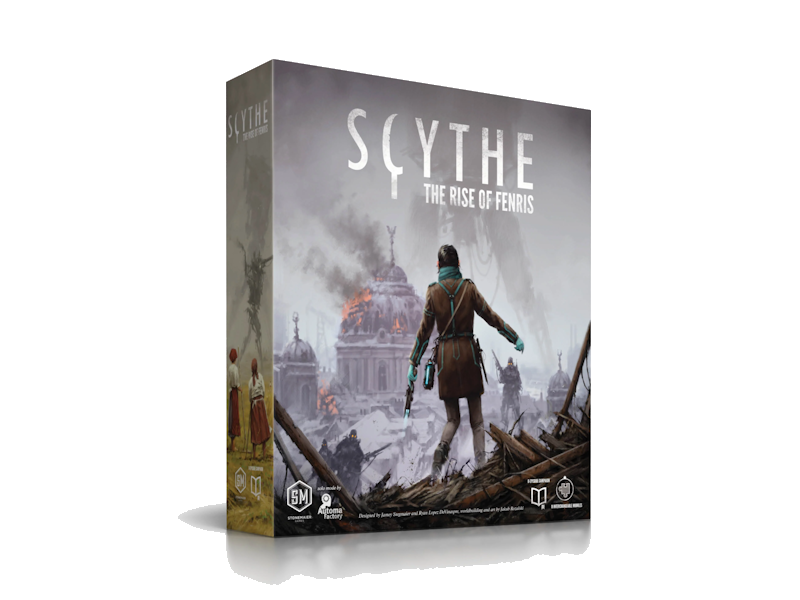Scythe: The Rise Of Fenris
review by Luka
Read This Before Scrolling!!!
Before scrolling down, keep in mind that Scythe: The Rise of Fenris contains not only 13 new modules to play around with, but a narrative campaign that introduces 11 of these modules. Therefore, I’ve divided this review into two sections: a spoiler-free section, and one that will contain spoilers. In the spoiler-free section, I won’t be divulging much information about the modules that are featured in the campaign, but I will be sharing my general thoughts and feelings about the campaign and expansion. The section containing spoilers, however, will go into more detail about the modules introduced by the campaign, but it won’t delve much into what was already covered in the spoiler-free section. So if you want to read about the modules and don’t mind spoilers, I recommend reading both sections. If not and you wish to avoid the spoilers, be careful with how far you scroll down.
Spoiler-Free Review
General Thoughts
Scythe: The Rise of Fenris is an expansion to Scythe that contains a replayable 8-game campaign that also serves to introduce 11 of the 13 modules the expansion adds. As an introduction to these modules the campaign does a good job at explaining how these modules work not only in the campaign context, but in regular games as well. Additionally, the modules add extra interest to the campaign as some of them aren’t only active for one game, but several games, or some modules that are introduced change depending on the players’ choices. Some campaign games, however, don’t introduce new modules, but they do involve new mechanics that serve a greater narrative and gameplay progression purpose. These create very interesting games that stand out, testing player strategy as they adapt and reward them with more choices. When I played, these elements gave me a stronger sense of player progression and agency that was rewarded for playing well.
As a campaign, The Rise of Fenris expansion is also fairly replayable. Of course you won’t have the same feeling of discovery you will have the first time you play, but just like in the original Scythe game, The Rise of Fenris provides achievement sheets to track the victors across every game and full campaign you play. Furthermore, personal score sheets to track your progress throughout a campaign, thus giving tangible proof of improvement as you play.
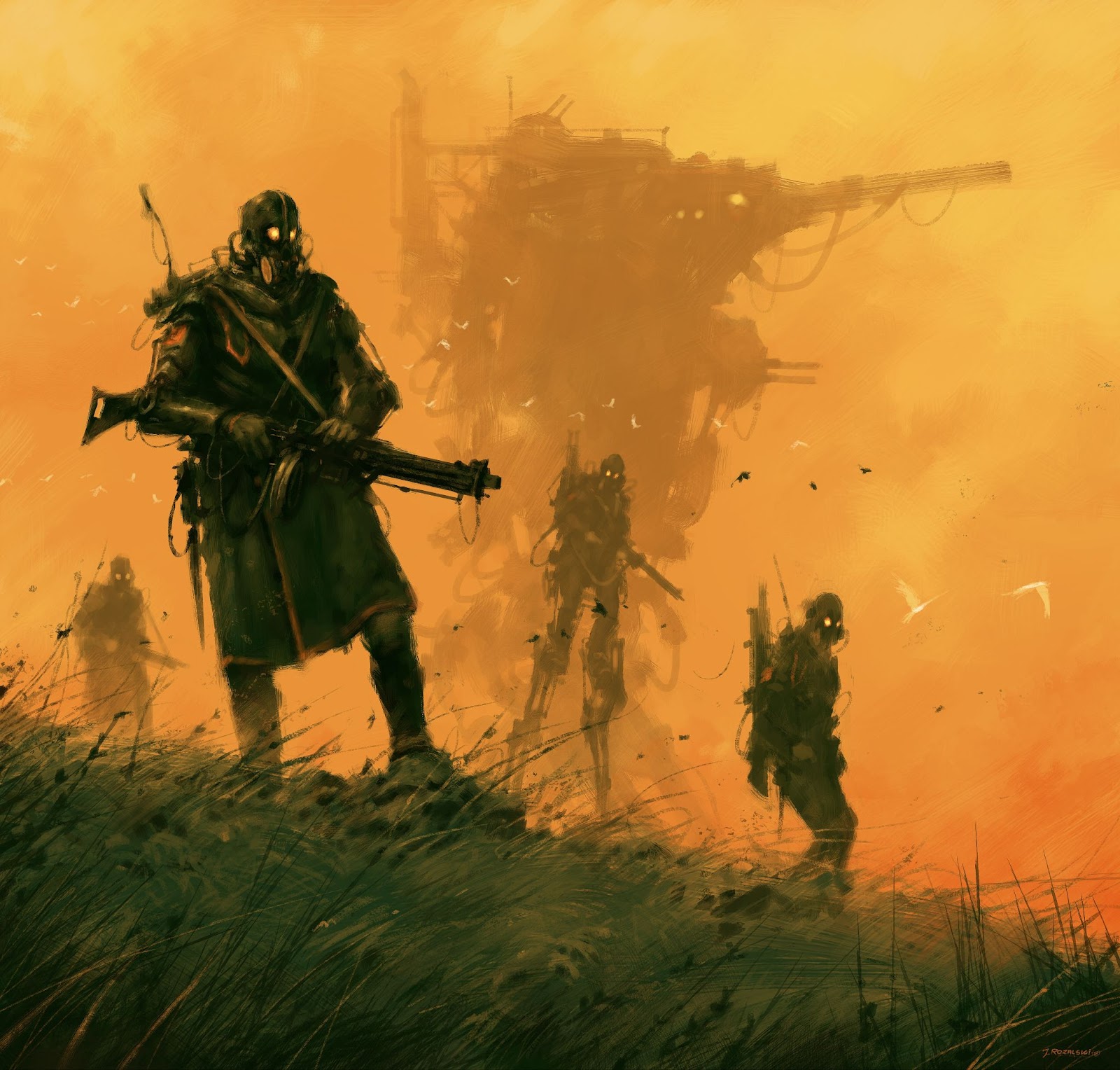 “1920 - Silent Guards”, this art is printed on the back of the box
“1920 - Silent Guards”, this art is printed on the back of the box
As expected, the art from Jakub Rozalski continues to be stellar. The art in Scythe: The Rise of Fenris shares the same features that makes the base game’s art stellar, with ominous mechs that loom over farmlands in a style that evokes the landscape art of Eastern European artists in the 1800’s. Unlike the base game however, The Rise of Fenris adds an overarching narrative that elevates the art via the context it presents. As a result, I felt very much immersed in the game’s world.
Ultimately, I find The Rise of Fenris to be a fantastic expansion to the base game of Scythe. Not only do you get a variety of modules to spice up regular gameplay, but you have a replayable campaign that effectively teaches the modules with a great feeling of progression and agency through a story that gives context to the art. I recommend this expansion to three types of people. The first group of people I recommend it to are people who love the base game, and want new ways to curate a game experience their play-group enjoys. The second group are people who love Scythe, but desire overarching progression with games they play. And the third group are people who are curious about the greater narrative of the 1920+ world created by Jakub Rozalski.
Modules Not in the Campaign
The modules outside the campaign are the Desolation module, which adds a cooperative way to play Scythe, and the Multiplayer Automa module, which enables the use of Automa in multiplayer games.
Desolation Module
In the Desolation module, all players work together, racing to defeat the Desolation faction by getting 1 star on each Triumph category or by destroying all of the Desolation faction’s units within 18 rounds. The Desolation faction is an inactive faction chosen by the players who has its combat units start around the factory; they act at the end of each round. At the end of the 6th round, the Desolation units start moving. This provides a buffer for players to establish themselves on the board first before potentially being attacked. Additionally, if a player wins a combat against the Desolation faction, they become stronger with more power for the next fight. This adds a careful consideration when strategizing an attack: you could get some early combat stars and remove some combat units early in the game to add some breathing room in parts of the map by attacking early before the Desolation faction moves. But doing so also makes defending when the faction moves much more difficult.
Multiplayer Automa
The Multiplayer Automa module offers a way to play with Automa rules in a multiplayer game. As a result, Automa factions can stand in for other players when you have a limited amount of human players available. Or you can play a cooperative game of humans vs Automa factions. However, the rules do stipulate that this module is semi-official, as it hasn’t gone through as extensive testing as the designers would like, yet it remains popular among players. Additionally, for each Automa faction, you need a deck of Scythe Automa cards. Since Scythe only comes with one deck, the rules provide and recommend using fan-made apps and websites to enable this mode of play.
!Spoiler Review!
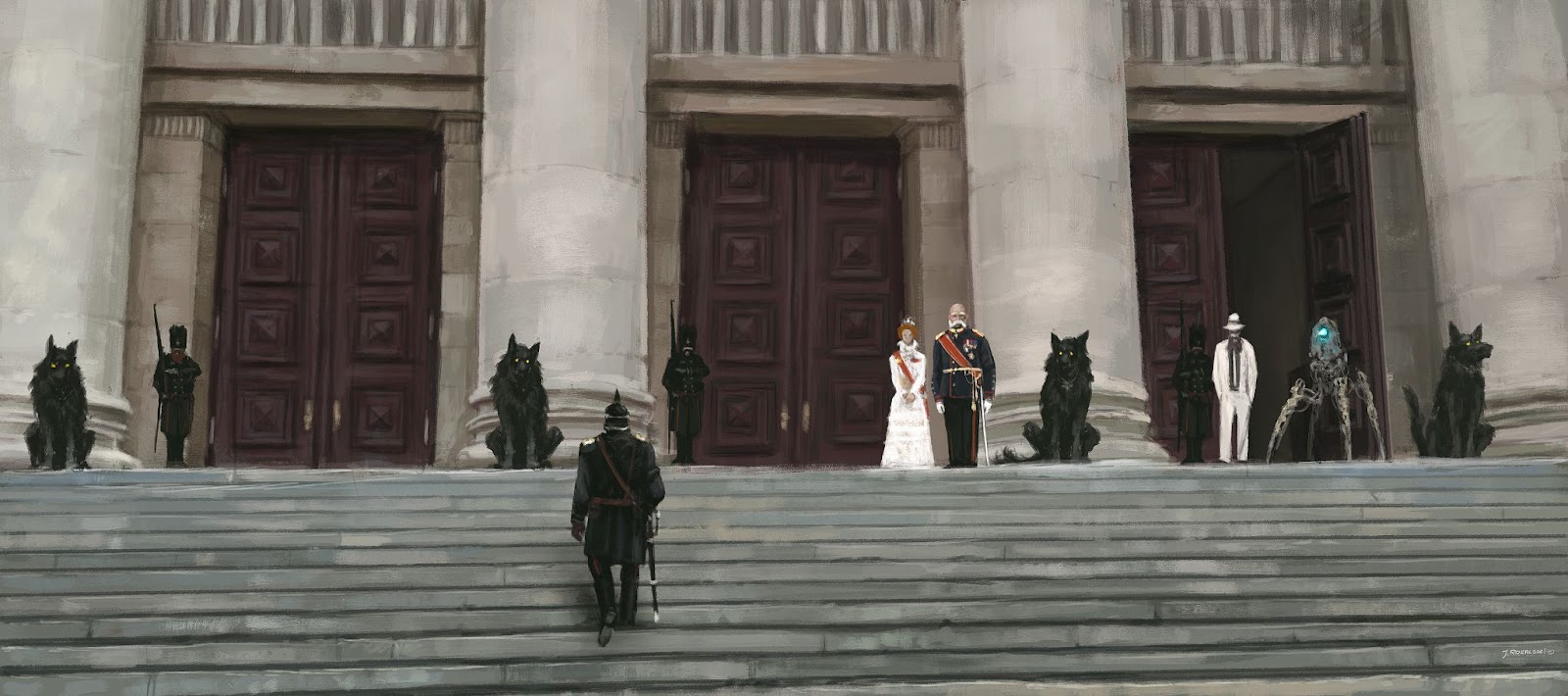 “1920 - Foundations of the Empire”
“1920 - Foundations of the Empire”
Scythe: The Rise of Fenris is an expansion to Scythe that contains a replayable 8-game campaign that also serves to introduce 11 of the 13 modules the expansion adds. The 11 campaign modules are:
- Mech Mods
- Infrastructure Mods
- A War Triumph Track
- Rivals Module
- A Peace Triumph Track
- Alliances Module
- Modular Triumph Tiles
- Two new factions
- Vesna
- Fenris
- Two versions of Tesla
- Regular Tesla
- Mad Tesla
The campaign does a good job introducing these modules in a manner that doesn’t overload you. For instance, the games after the new factions are introduced are much less complex, only utilizing already introduced modules or less overwhelming new mechanics that are only present for that game. As a result, the players get to better situate themselves with the new faction. Sometimes, however, these new mechanics are very game altering, which create for incredible narrative and gameplay experiences.
Additionally, when starting a campaign, each player chooses a faction to play as. This creates a strong connection between players and the faction they’ve chosen. Though for the players who find themselves not too enthused about their faction choice, the campaign offers the flexibility for players to change factions after games, or even fight to become one of the new factions. This flexibility also extends to players who miss a game or players who join later in the campaign: because the overall victor is only determined with the last game, you aren’t so heavily punished for missing a game or two. As a result, both the players who like to stick with their choice and the players who like swapping factions can both be satisfied.
Modules
Mech Mods
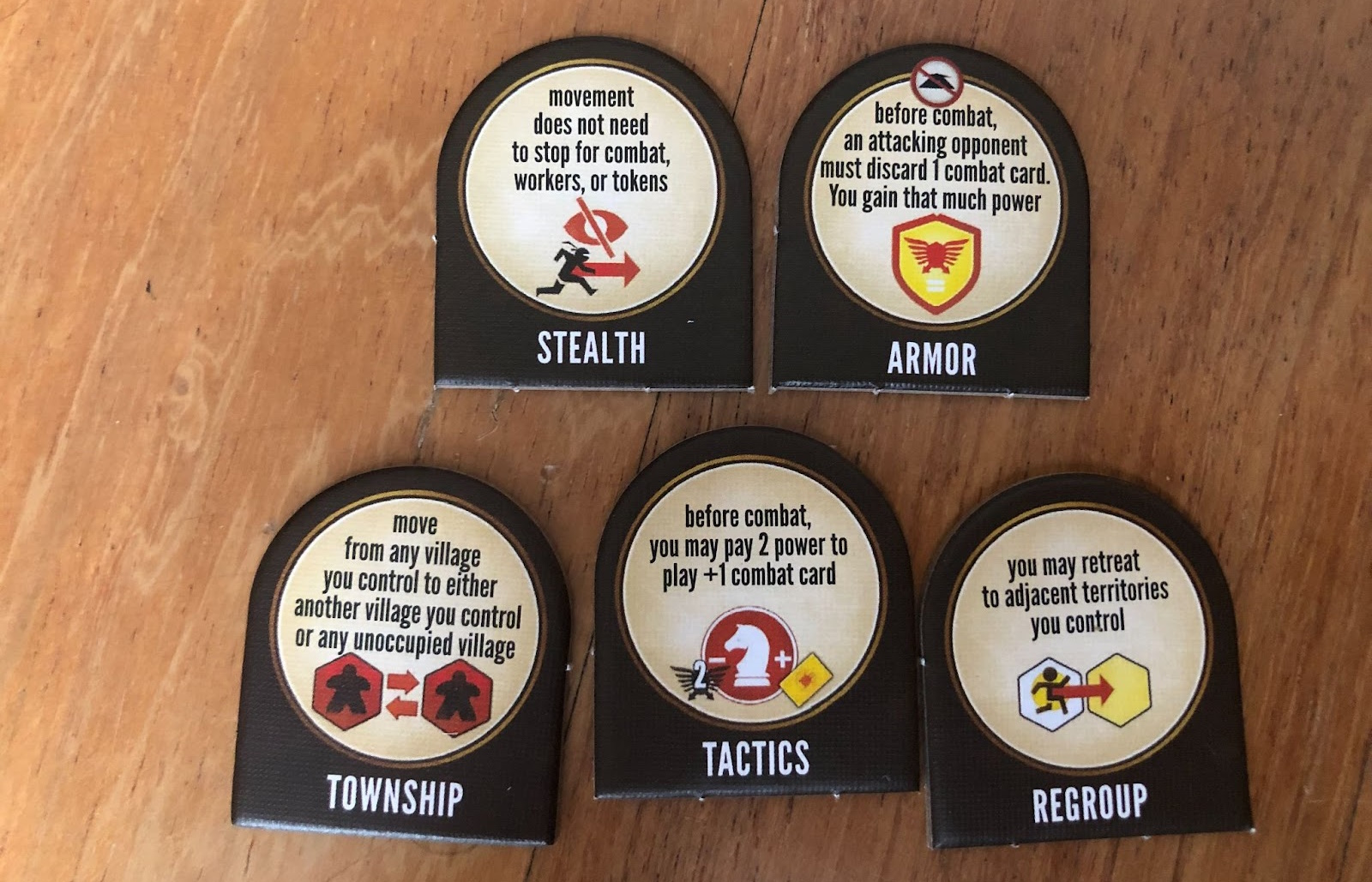 A set of 5 different mech mods
A set of 5 different mech mods
Mech mods add a method for players to experiment with new combinations of mech abilities. In the campaign, players can accumulate a collection of mech mods which they can choose to use each game to replace their mech’s regular abilities. In regular games of Scythe, each player draws 4 mech mods and can keep up to 2 of them.
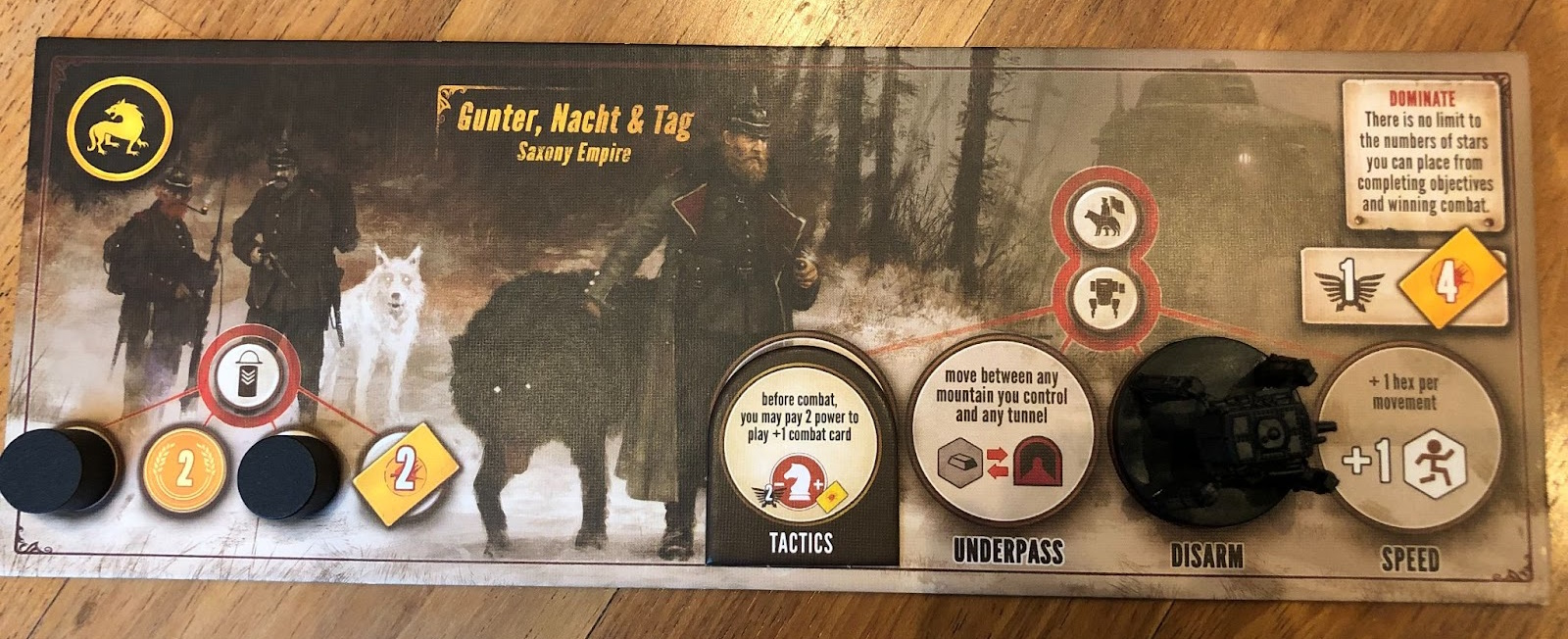 Saxony’s Riverwalk ability is replaced with the mech mod Tactics
Saxony’s Riverwalk ability is replaced with the mech mod Tactics
The customizability offered by mech mods enables interesting combinations that allow players to further specialize in certain strategies. For example, in the above image Saxony has replaced their Riverwalk mech ability with the Tactics mech mod. Since Saxony is already incredibly mobile with Underpass, there isn’t much need for the Riverwalk. Therefore the Tactics mech mod enables Saxony to specialize and be even more aggressive if they upkeep their power.
Infrastructure Mods
 A set of 5 different infrastructure mods
A set of 5 different infrastructure mods
Infrastructure mods are acquired the same way as mech mods are in both the campaign and regular games. Unlike mech mods though, infrastructure mods are a one time use ability that help players accelerate to late game, or have large impacts on combat. As a result, I think infrastructure mods are best to use in a regular game if players want a boost to get to the late game faster. In the campaign, the powerful effects of these mods give a very strong feeling of progression as your engine building will be sped up.
War Triumph Track
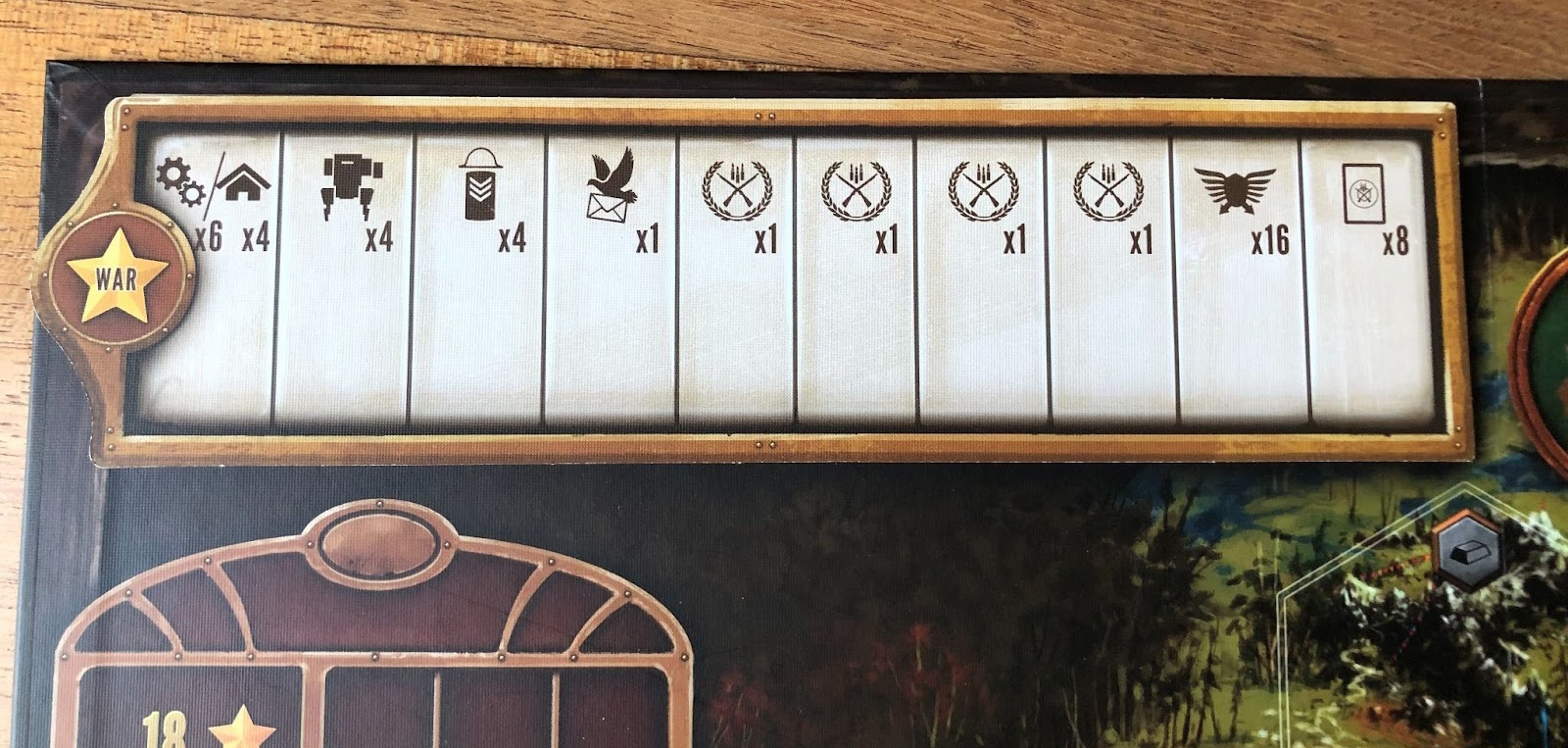 The War Triumph Track
The War Triumph Track
The War Triumph Track encourages players to interact more with each other, and less on engine building due to the triumph’s conditions. Players can no longer score for maximum popularity, nor can they get a star for having all 8 workers out. Furthermore, the 6 upgrades and 4 structures achievements are both combined. Instead, players can score up to 4 combats and for having 8 or more combat cards in hand.
I find this version of Scythe really flips the game on its head for the games that it's present in: typically, players don’t fight often due to combat being incredibly costly. I definitely recommend giving this track a try, even if you enjoy the engine building aspect of Scythe more fun than the fighting. It becomes really tense and sometimes funny as players posture with their power much more often, and take more opportunistic jabs.
Rivals Module
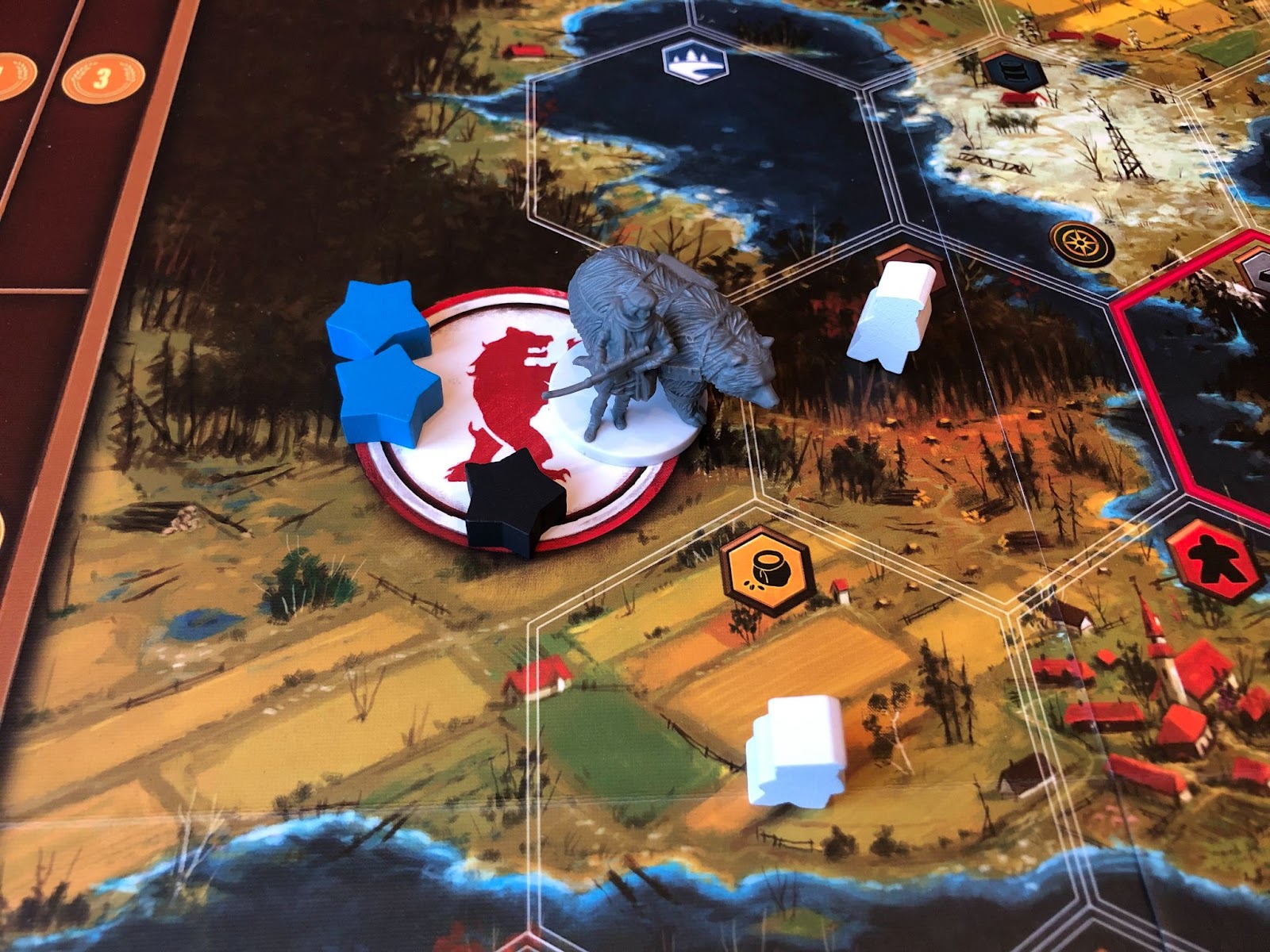 Here, the Saxony player has placed one star on Polania and the Nordic Kingdoms placed two, making Polania Saxony's and the Nordic Kingdom's rival
Here, the Saxony player has placed one star on Polania and the Nordic Kingdoms placed two, making Polania Saxony's and the Nordic Kingdom's rival
The rivals module is a simple, but very engaging addition to Scythe. Before the game starts, each player assigns a number of combat stars that can be scored to any number of active factions when using this module (2 using the regular Triumph track, 4 when using the War Triumph Track). This action essentially boils down to players betting who they’ll fight and win against. In the game, when the player wins a combat against one of their rivals, they take the star assigned to them and score as usual, but they additionally gain $5. If needed, each star assigned to a rival can be gained for a combat against another non-rival player. In these cases, you do not gain $5.
I love this module for its simplicity and effectiveness. Through this module, more player interaction is encouraged to offset the negatives for investing too heavily into fighting. Additionally, the act of assigning rivals builds tension and introduces some mind games right from the start. Sure, players don’t have to fight their rivals to score their stars, but you don’t know who your rival will fight! There’s always the threat that your rival may come for that money incentive, and by extension, you can inflict that same mental strain on other players!
Peace Triumph Track
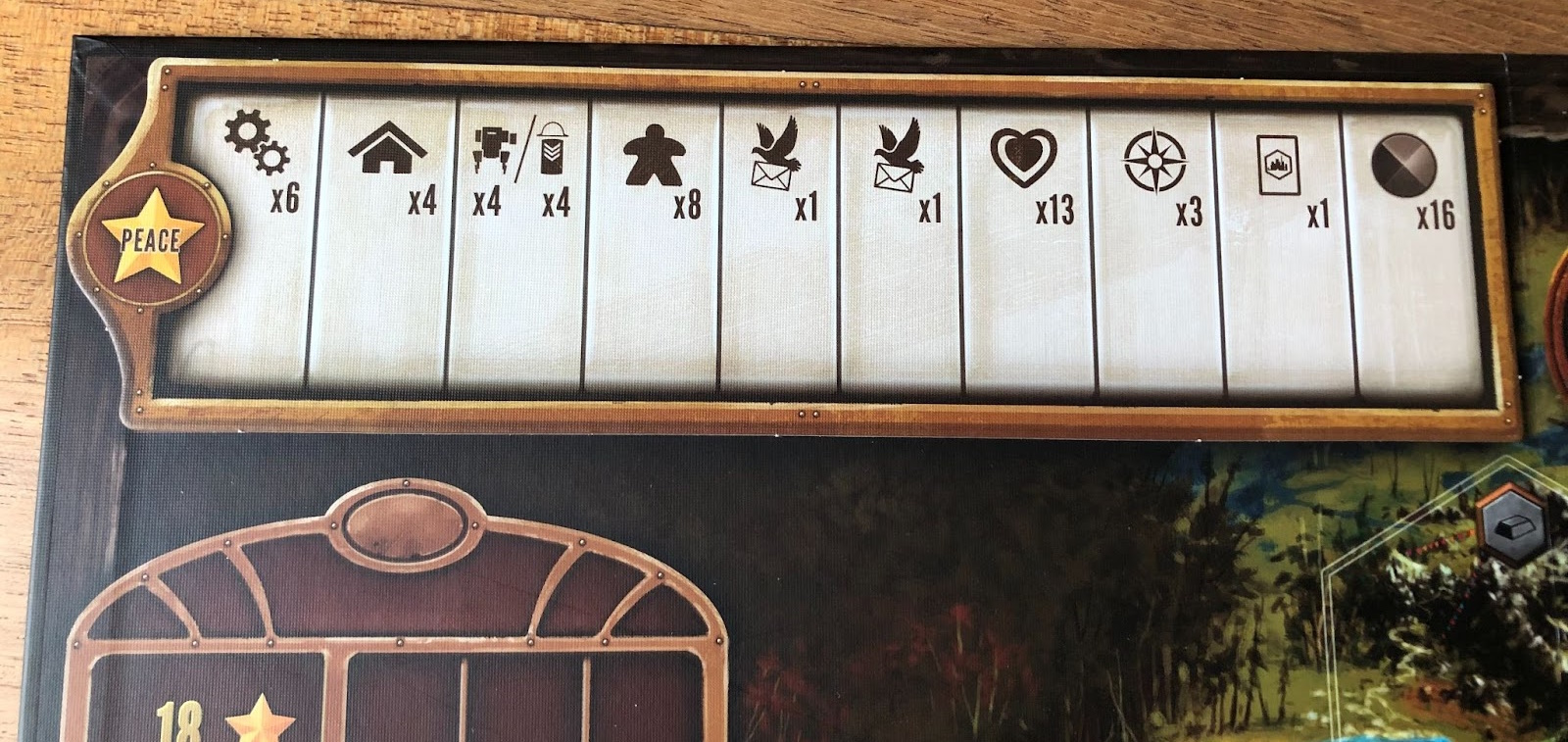 Peace Triumph Track
Peace Triumph Track
The Peace Triumph Track pushes player’s efficiency to the max, removing the triumphs for combat victories, max power, and combining deploying mechs and enlisting recruits. Instead, players are pushed to make an incredibly efficient engine as fast as possible to place their stars. But not only will they race for efficient engines, but for encounters and a factory card as well. As a result, this scoring track is best for players who enjoy the engine building and exploring mechanics of Scythe more. Can you beat your friends in this race?
Alliances Module
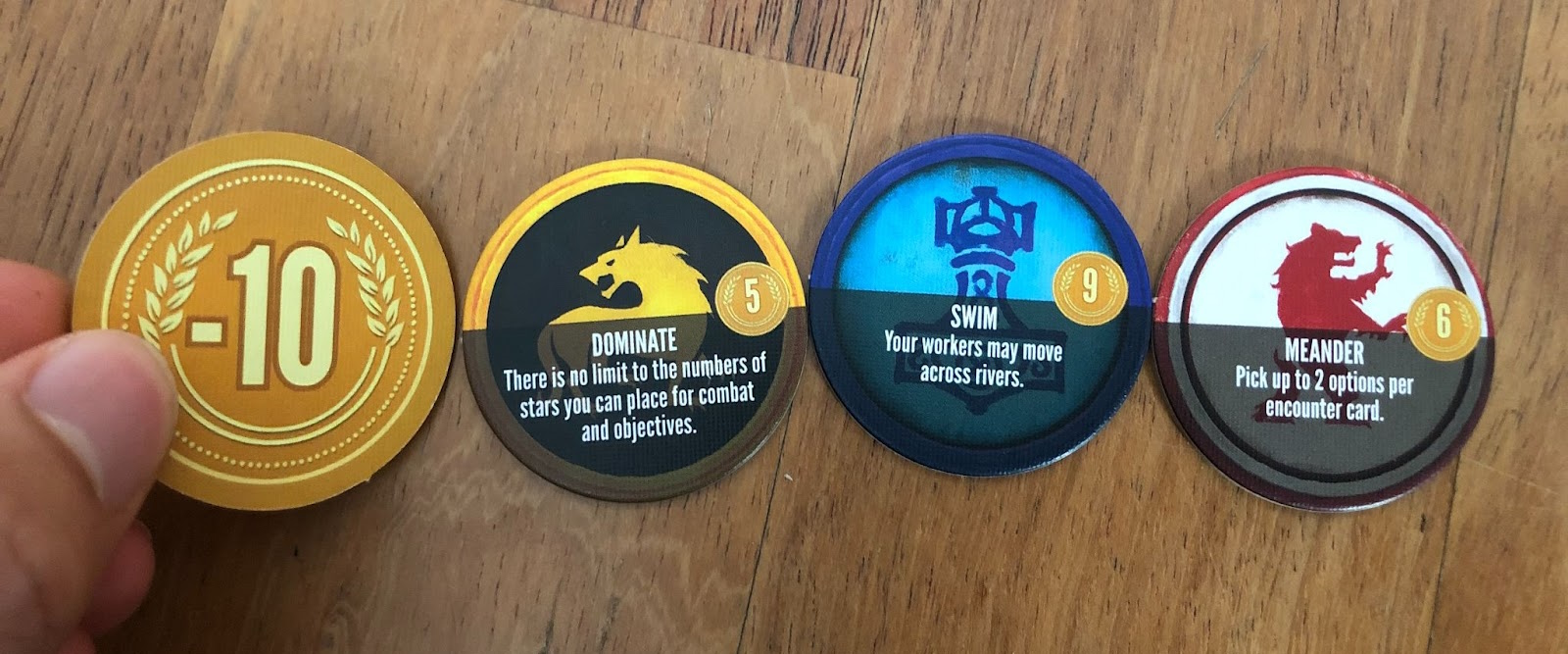 Alliance tokens for Saxony, Nordic Kingdoms, and Polania. The -10 is the back of another token
Alliance tokens for Saxony, Nordic Kingdoms, and Polania. The -10 is the back of another token
The Alliance module adds a diplomatic angle to gameplay with pseudo-alliances. At the start of the game, each player has their faction’s alliance token. On your turn, you may propose an alliance with another player. If they agree, you gain the number of coins on their alliance token and you swap tokens. You now have the ability on the token, which is their faction ability, until you attack your ally. Once you attack your ally, you no longer get the token ability and instead suffer a -$10 penalty at the end of the game. Your ally, however, incurs no negative effect for your treachery, until they decide to be treacherous themselves, in which case they’ll suffer the same effects.
The Alliance module adds an interesting dimension to gameplay through the ability to stack faction abilities: imagine any other faction with the Rusviet’s faction ability! Outside of the possibilities of stacking abilities, another aspect of depth presented by this module is that positioning becomes so much more impactful when negatively affecting your ally. If you position yourself in a very inconvenient location for your ally, you can force them to attack you, thus losing the ability you granted and losing money later in the game.
Modular Triumph Tiles
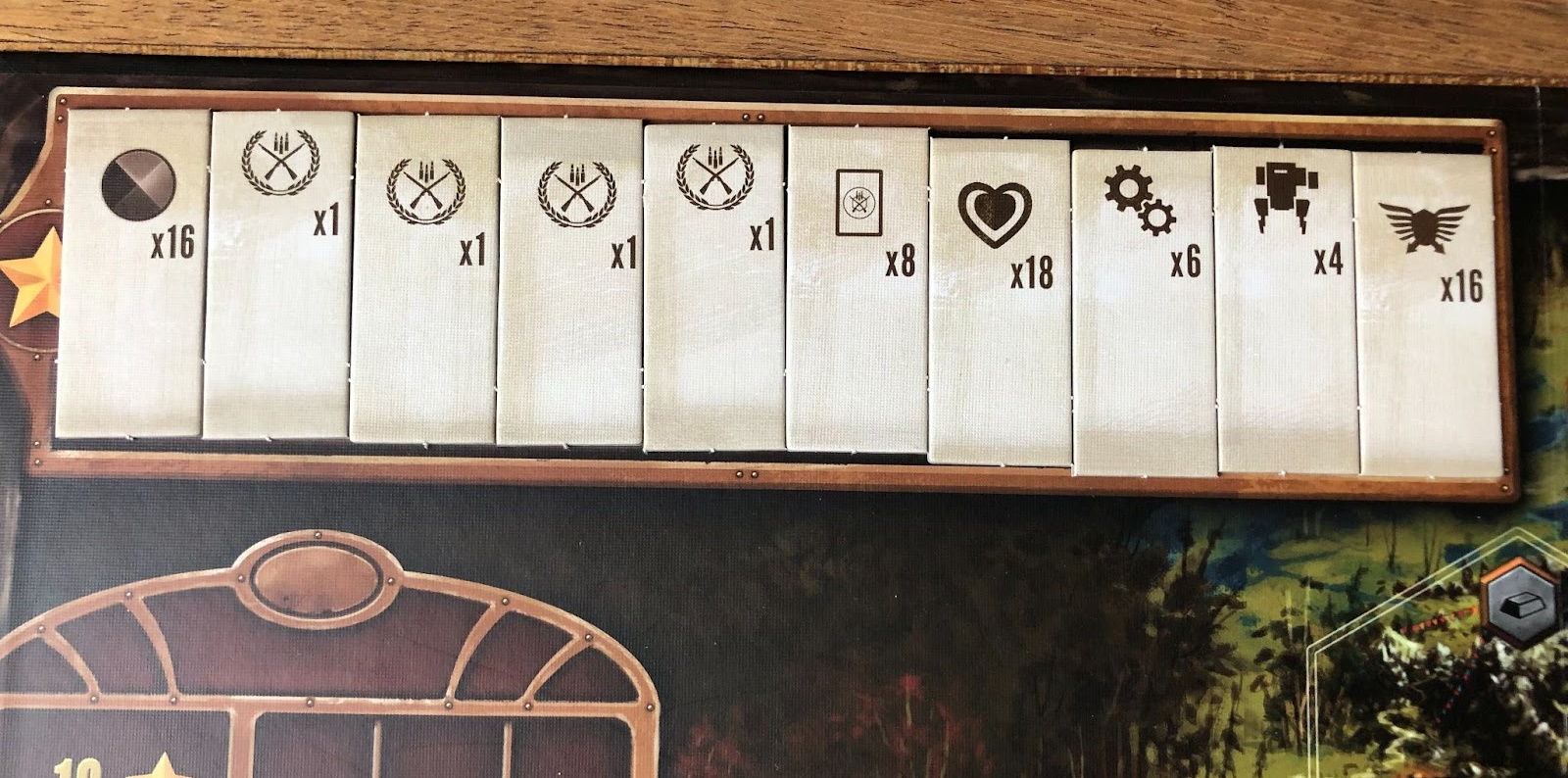 All 10 of these tiles are randomly chosen and placed
All 10 of these tiles are randomly chosen and placed
For a truly modular experience, the modular triumph tiles add the ability to choose random tiles for the triumph track. Or, you could curate a selection of tiles to push a certain style of gameplay among you and your friends.
Vesna Faction
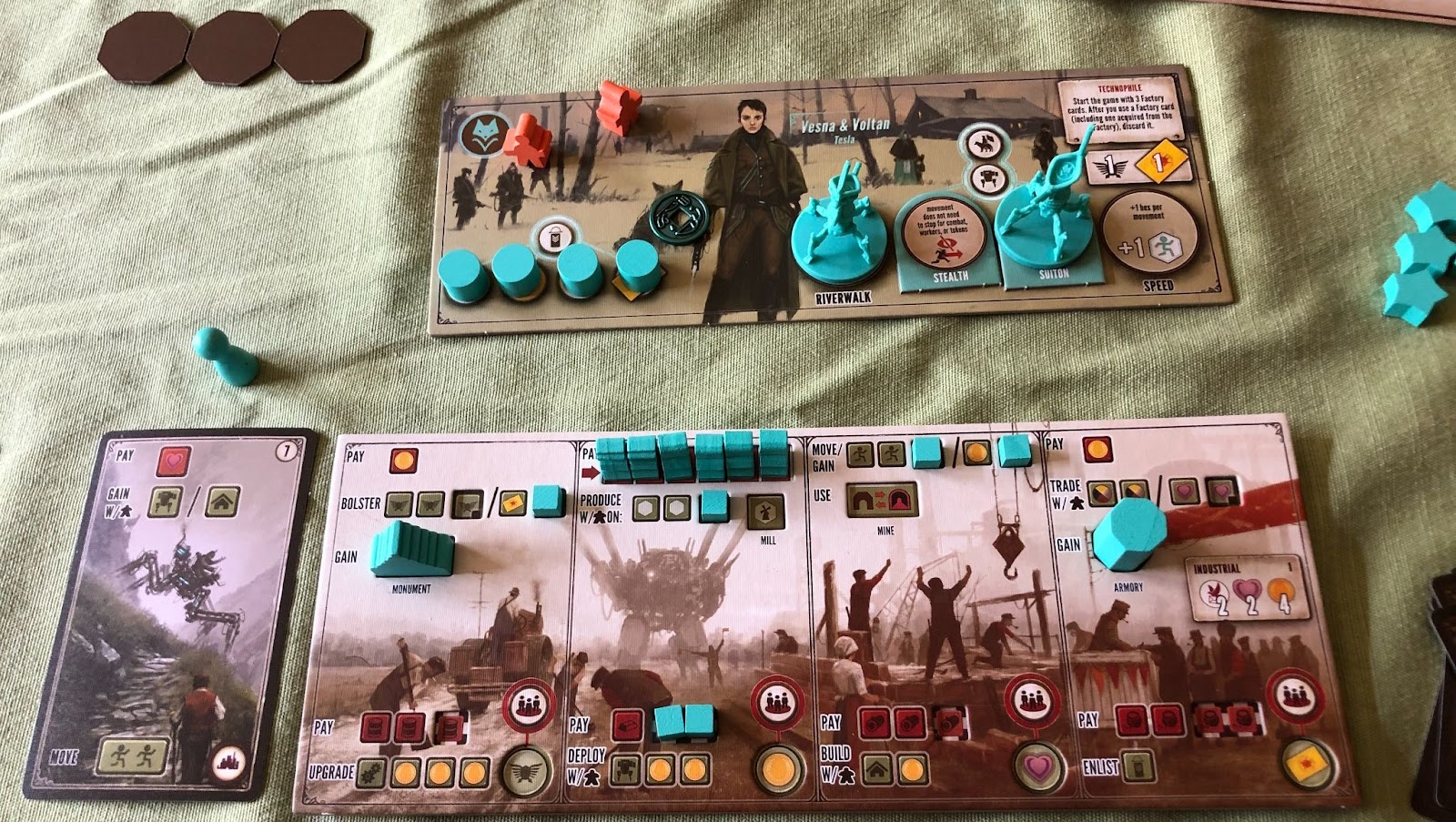 Vesna faction mat and player mat mid-game
Vesna faction mat and player mat mid-game
The first faction added by The Rise of Fenris is Vesna, the fictional daughter of Tesla in this alternate world. Vesna is particularly unique as a faction in three major ways. For one, she doesn’t have a standard start location as other factions do. Instead, she uses an unselected faction’s home base as her own each game. The next way she’s unique is that she actually starts the game with 3 Factory cards, however each Factory card is a one-time use for her (including the one she gains for entering the Factory). Lastly…
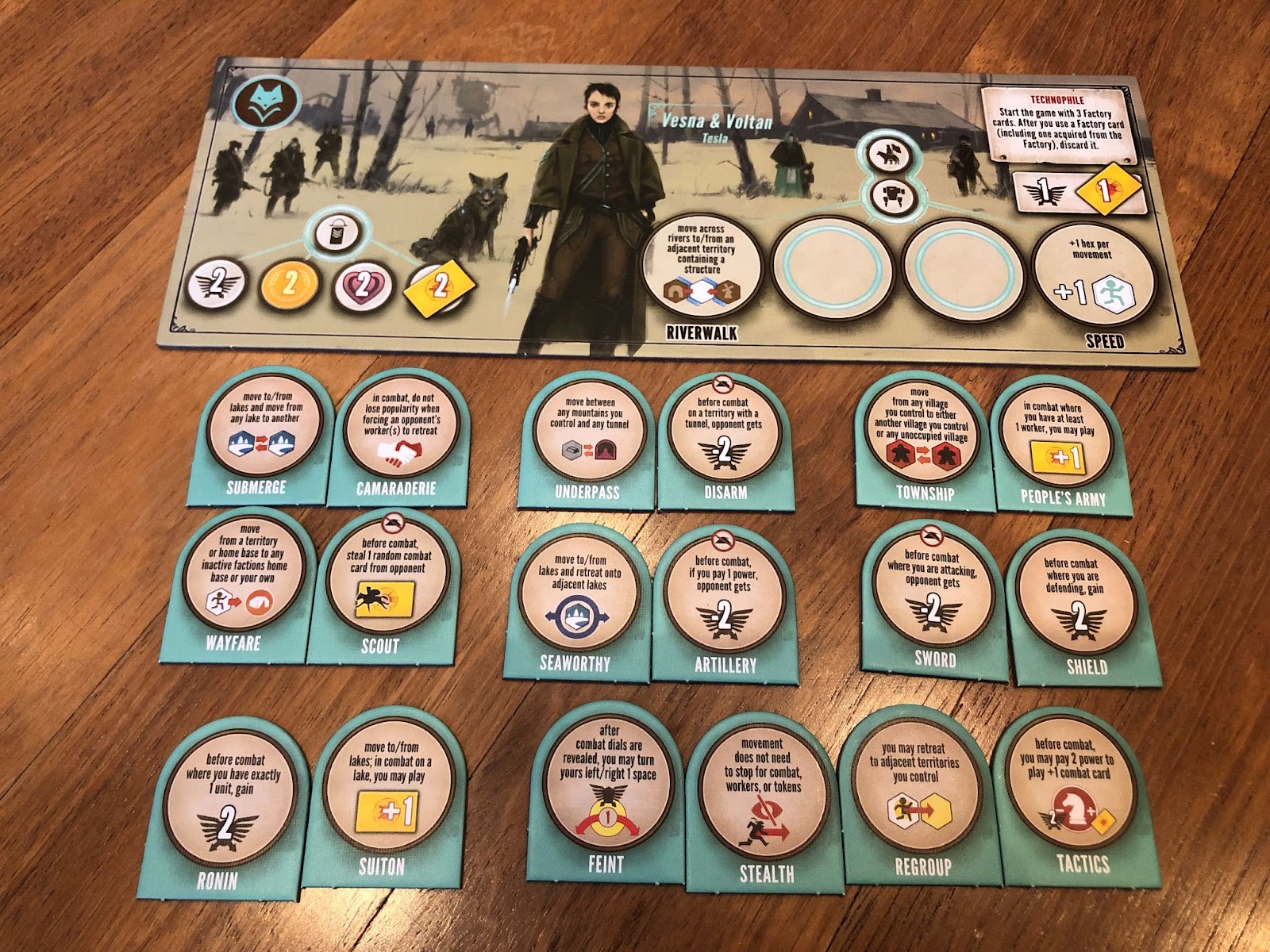 Vesna Faction Mat with all possible mech ability tokens
Vesna Faction Mat with all possible mech ability tokens
Vesna is also unique due to the fact that her faction board doesn’t actually have 2 of the 4 mech abilities slots with any set ability. Instead, the Vesna player only gets Riverwalk and Speed as guaranteed abilities, and must draw 6 random mech ability tokens at the start of each game. The Vesna player then selects 2-4 of the mech ability tokens to place on her faction board, much like mech mods.
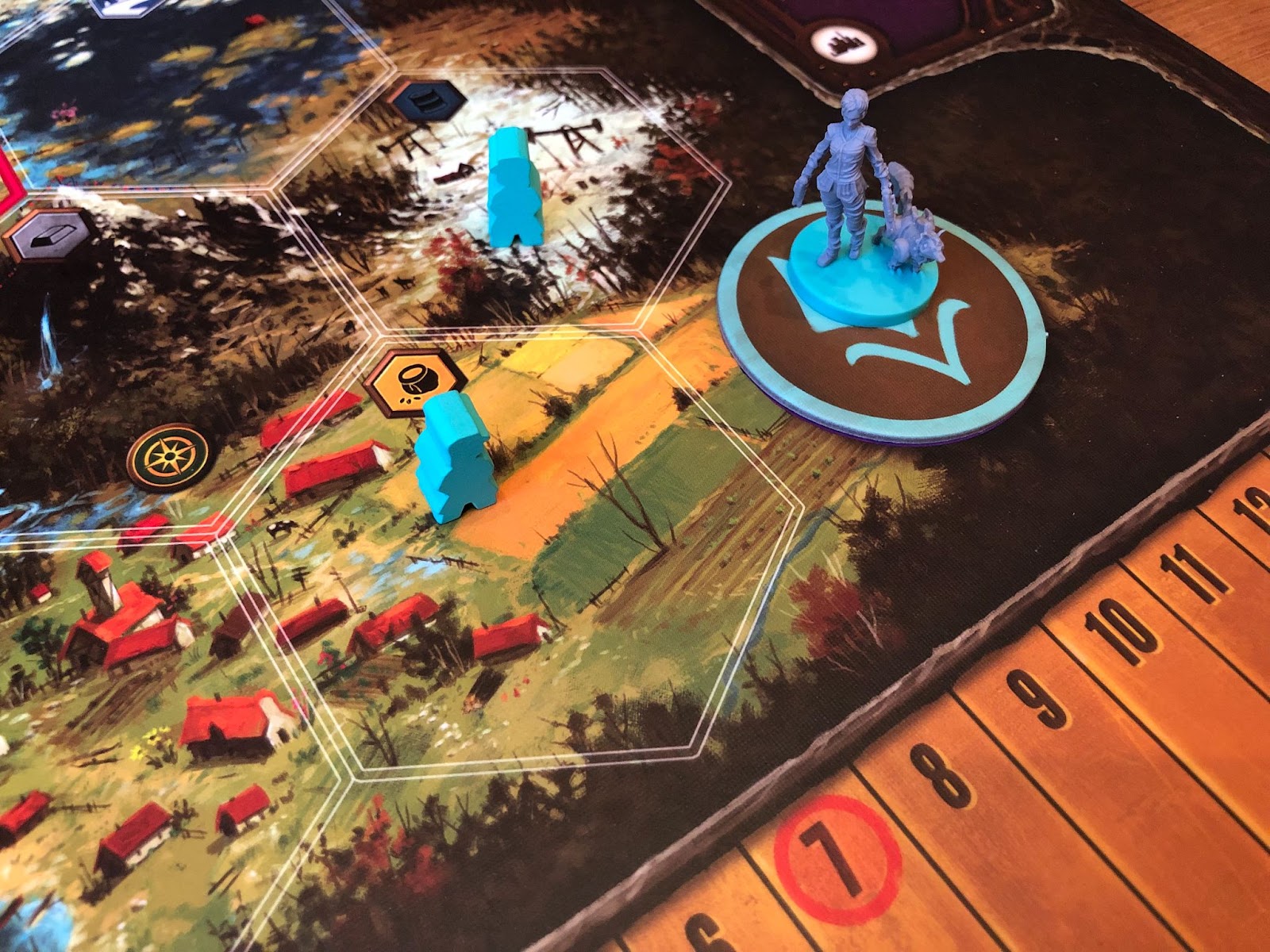 Vesna character figure using Togawa’s home base as her own
Vesna character figure using Togawa’s home base as her own
Because of the amount of variability Vesna’s faction has, it is a difficult faction to play because you don’t have a “solved” or straightforward way to play her; she’ll be different every game. However, for experienced players, Vesna is incredibly fun to play as she really tests player game knowledge, and her mech abilities really push customizability and specialization, even more so than the mech mods. For example, with a combination of the mech abilities Underpass, Submerge, and Township, the Vesna player can truly be everywhere at once to respond to or flee from any threat. Combine this ridiculous movement with the Speed ability and wise use of the Factory cards and the Vesna player can do things like have a unit Submerge on a lake tile, move out of another lake onto a mountain, then move to a tunnel with Underpass.
Speaking of the Factory cards, you have to be prudent on when to use them: once you use one, it's gone forever. However, the amount of factory cards you have access to can push an early game advantage to a powerful position.
As a result, Vesna is truly the most variable and customizable faction. I really enjoy the unique challenges she poses each game I play her.
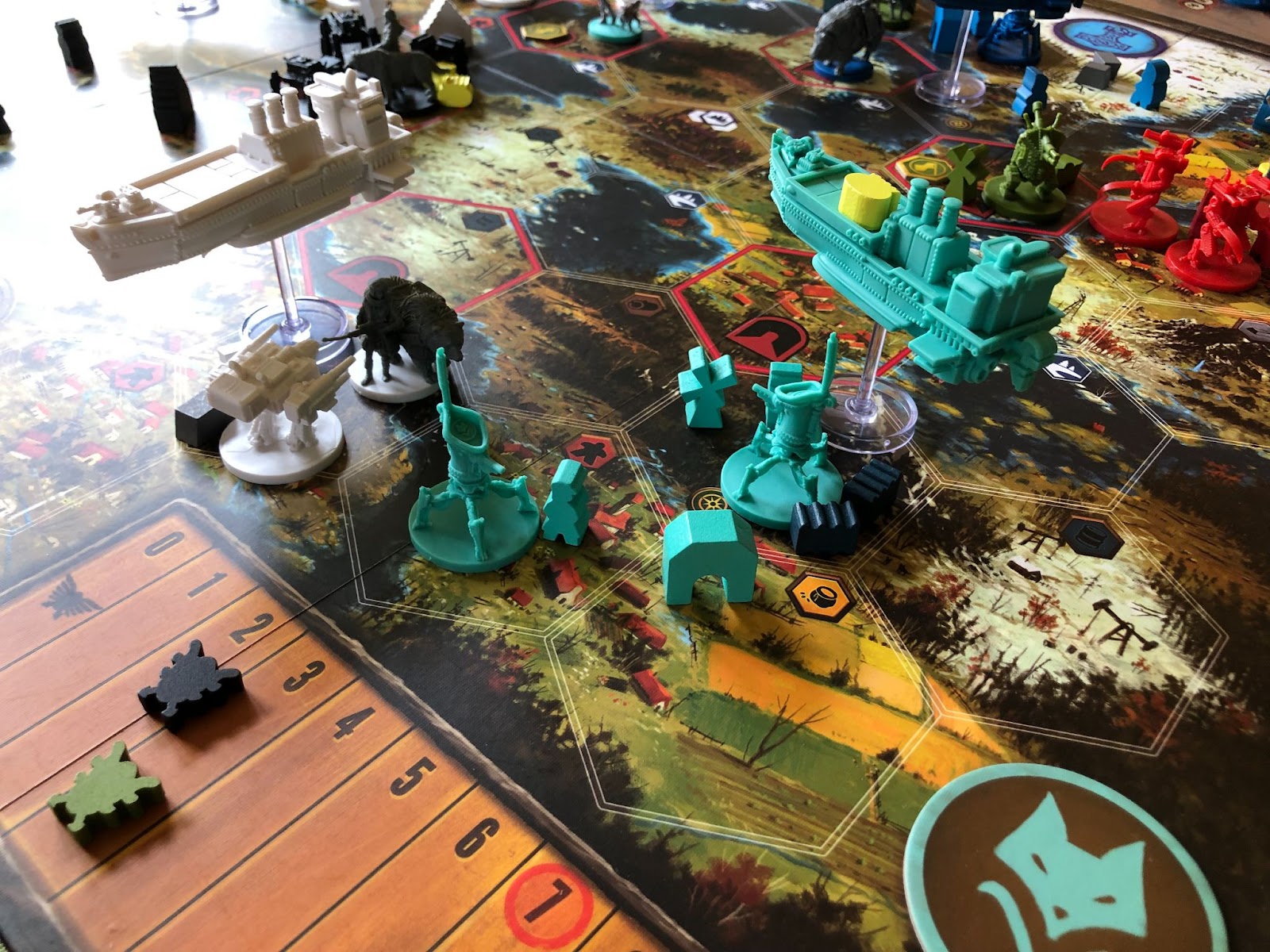 Vesna mechs on the board
Vesna mechs on the board
Fenris Faction
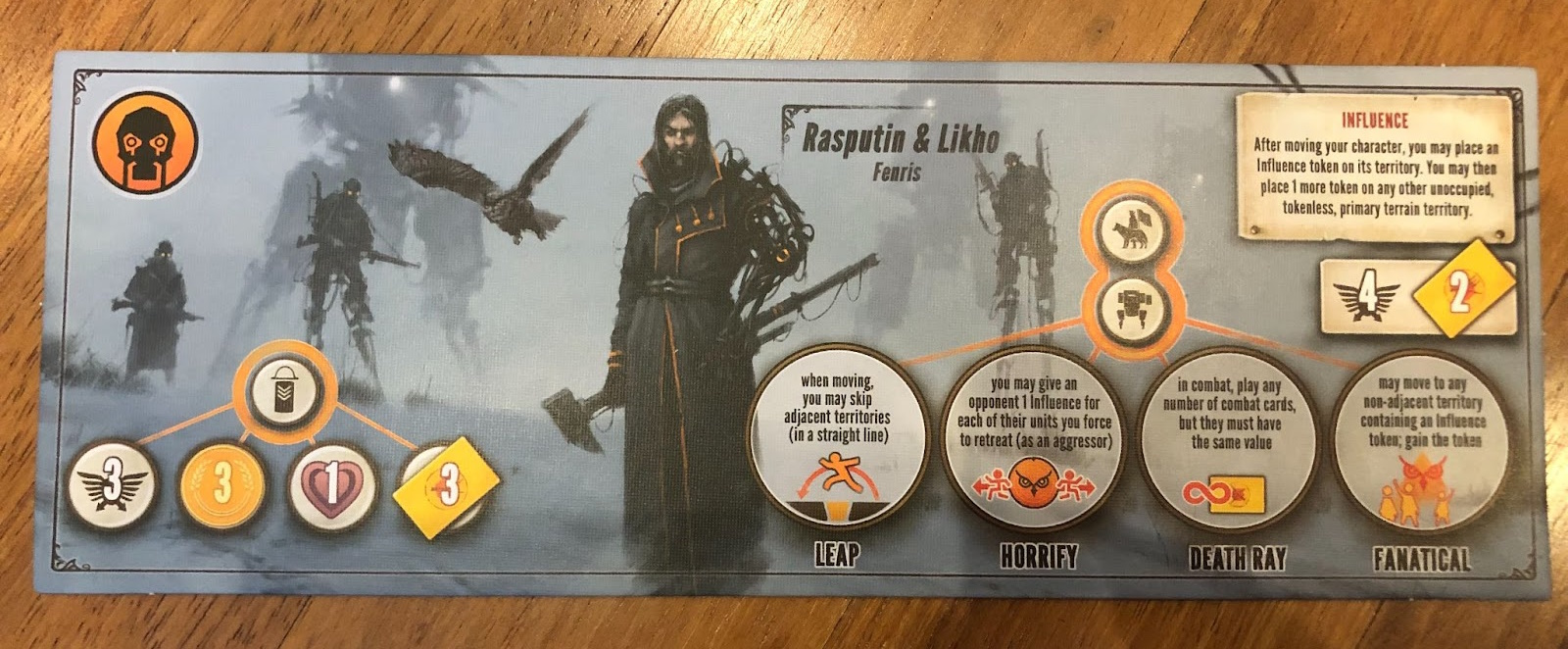 Fenris faction mat
Fenris faction mat
The namesake of the expansion, the Fenris faction is a terrifying opponent and intoxicating to play as on the table. They are one of the most aggressive factions in the game. As Fenris, you start at an unselected player’s home base (much like Vesna), and you gain 16 influence tokens. Each influence token at the end of the game is worth -$1, so you want to get rid of them as fast as possible!
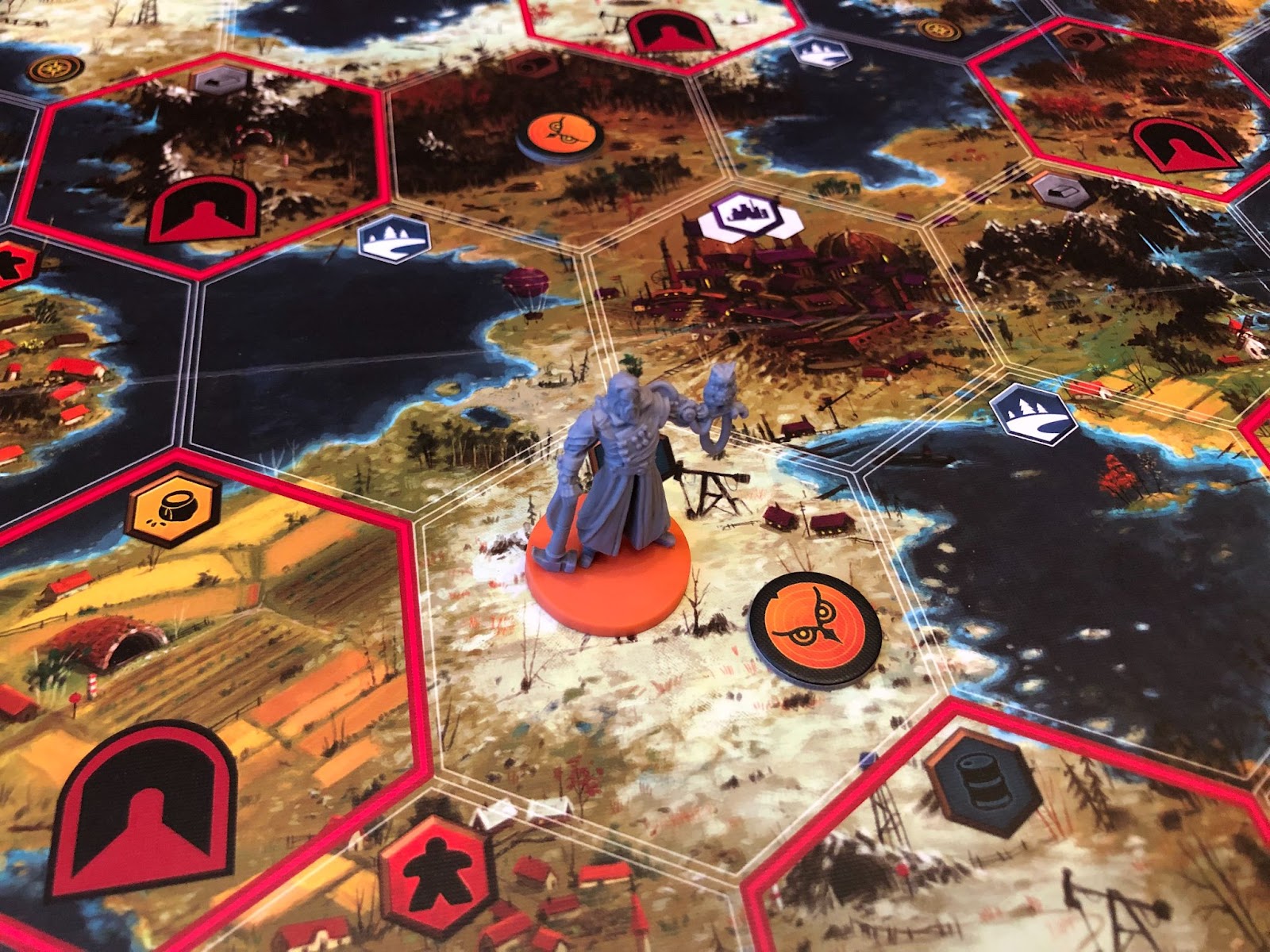 Rasputin placing down influence tokens on his territory and a territory above the factory
Rasputin placing down influence tokens on his territory and a territory above the factory
The easiest way to get rid of tokens is through the faction ability: when the leader character, Rasputin, finishes a move, you can place an influence token on his territory, and any other unoccupied territory that isn’t a lake or the factory. When an enemy unit walks into a territory with an influence token, they are forced to stop and pick it up!
 Rasputin in Crimea’s home base to start
Rasputin in Crimea’s home base to start
While Rasputin’s influence tokens slow down enemies and spring you into action trying to get rid of them, the mech abilities available lean into movement and combat. For movement, the Leap ability essentially combines Riverwalk and Speed abilities, as it grants his mechs the ability to skip over one territory to the next when moving in one direction. The Fanatical ability gives the Fenris player the flexibility to show up anywhere on the board where there’s an influence token, punishing enemies for not picking them up. Combat-wise, the Deathray ability allows an effectively infinite number of combat cards to be played, and the Horrify ability allows the Fenris player to give influence tokens to the loser, making combat an incredibly efficient way to hurt other player’s endgame scores.
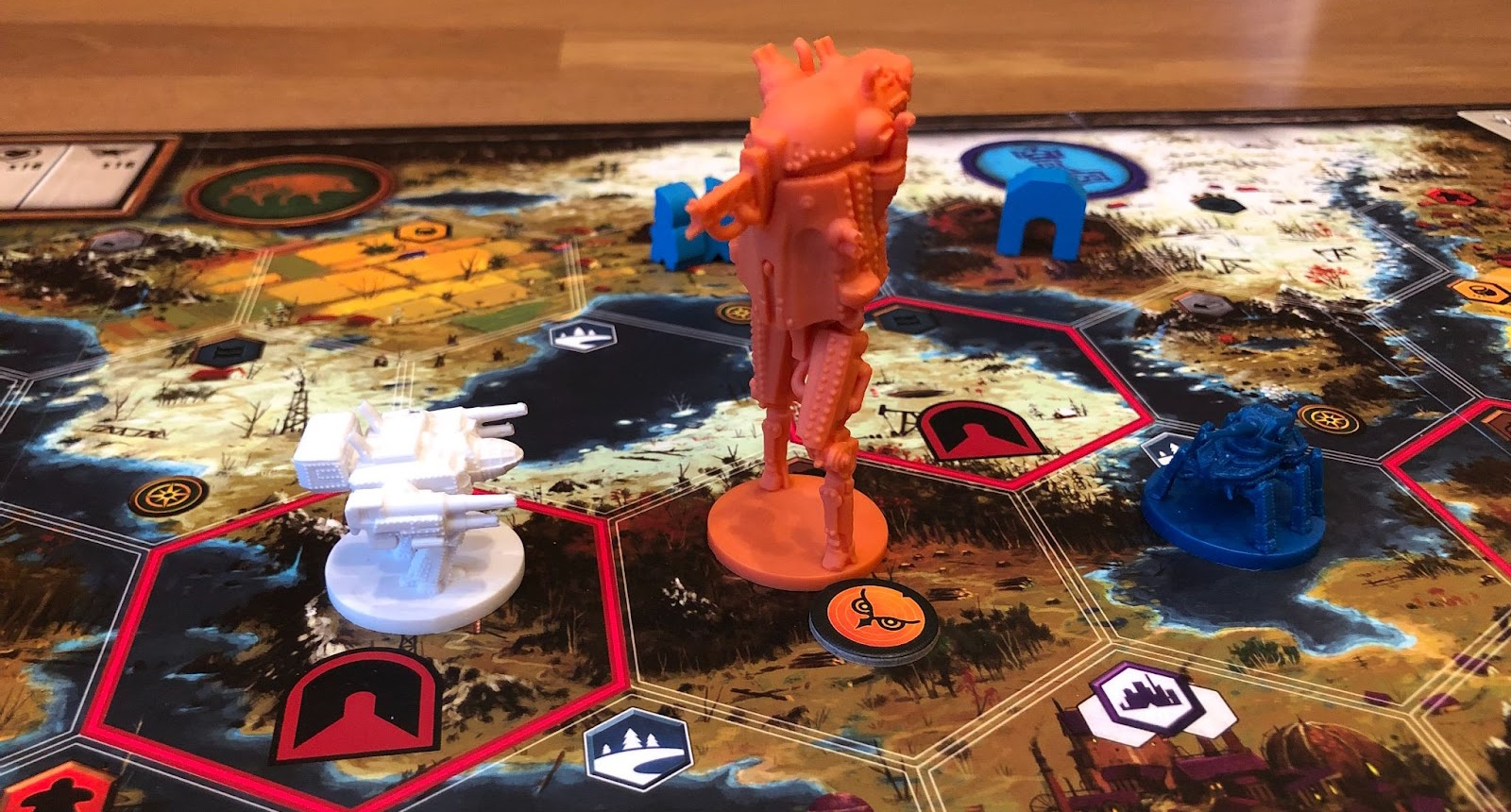 A Fenris mech next to a Polania and Nordic Kingdoms mech, respectively
A Fenris mech next to a Polania and Nordic Kingdoms mech, respectively
When you play Fenris on the tabletop, you do incur a level of pressure on your enemies no other faction can match. As a result, you truly embody the role of the antagonist on the table, and you have the power to swing your weight around too through the Deathray mech ability, and dissuasion influence tokens cause! Plus your mechs are physically massive!
Regular Tesla
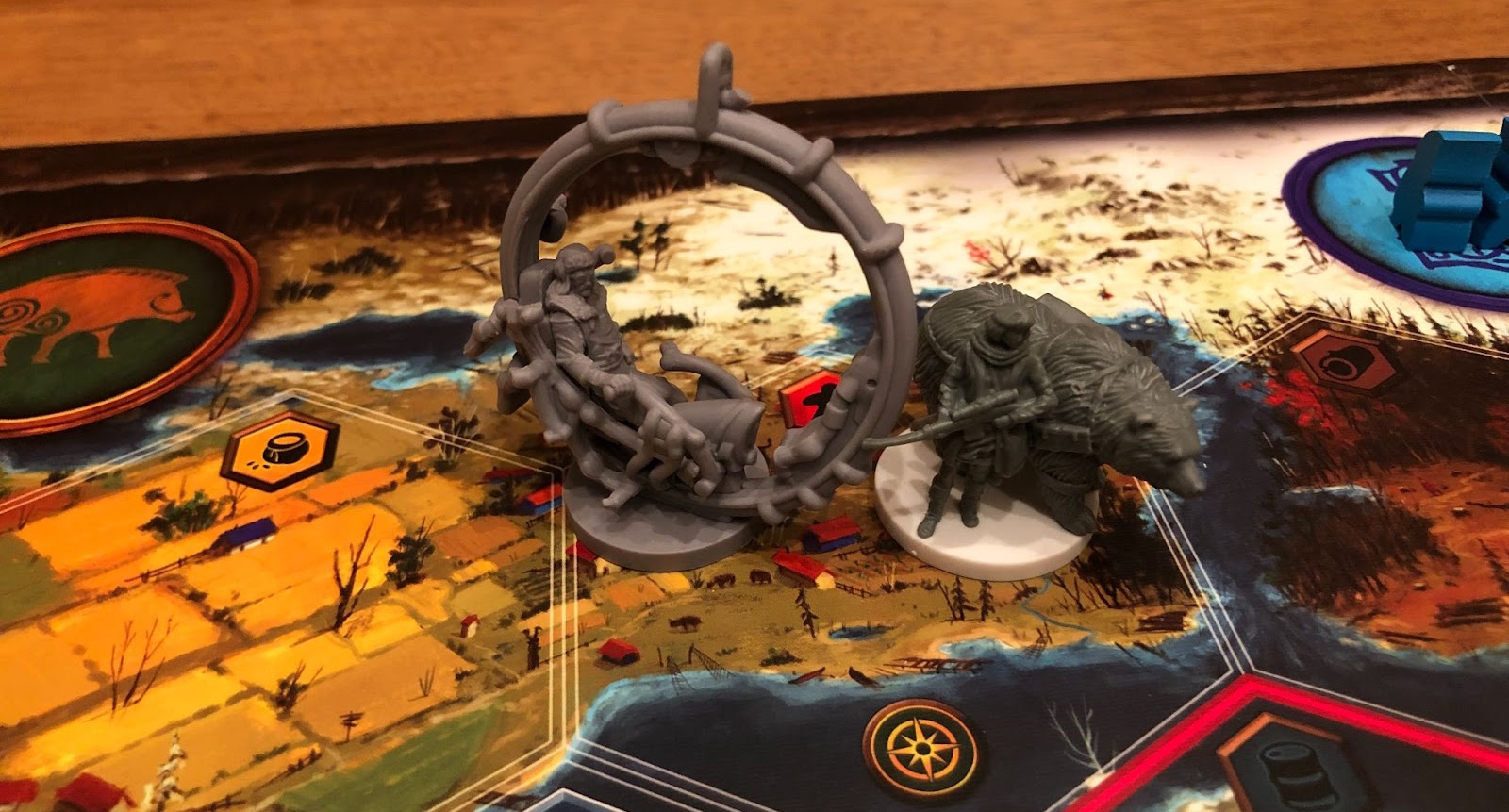 Tesla being found by the Polania player
Tesla being found by the Polania player
The Tesla module rewards players who seek out expeditions with Tesla himself! He acts as a character and mech model at the same time. He can therefore move workers like a mech, but interact with other encounters like a character.
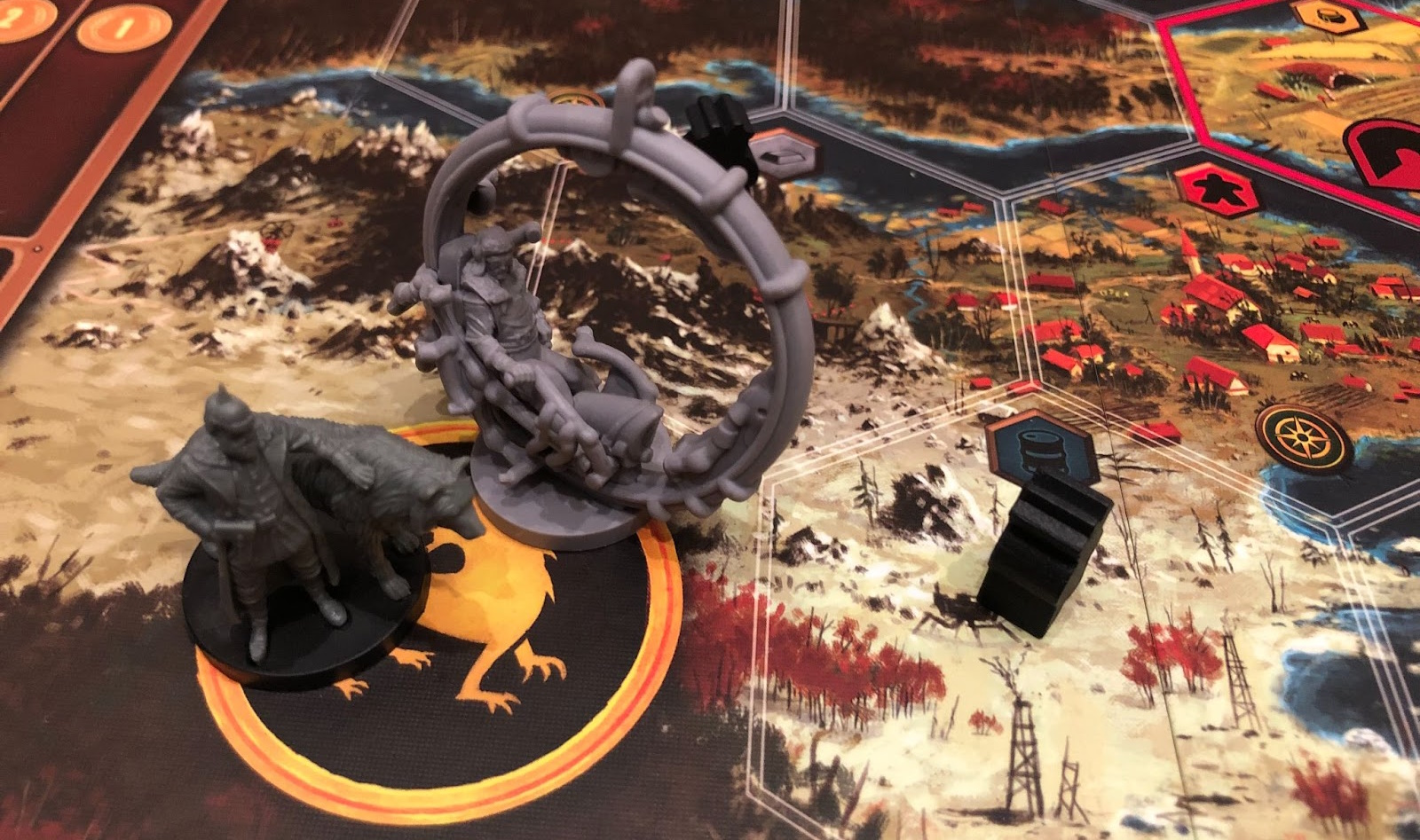 The Saxony player starting with Tesla as a handicap
The Saxony player starting with Tesla as a handicap
Another way to use Tesla is as a handicap to help boost a player’s performance. By allowing a player to start with him, it’s a simple way of giving them more flexibility and presence on the board.
Mad Tesla
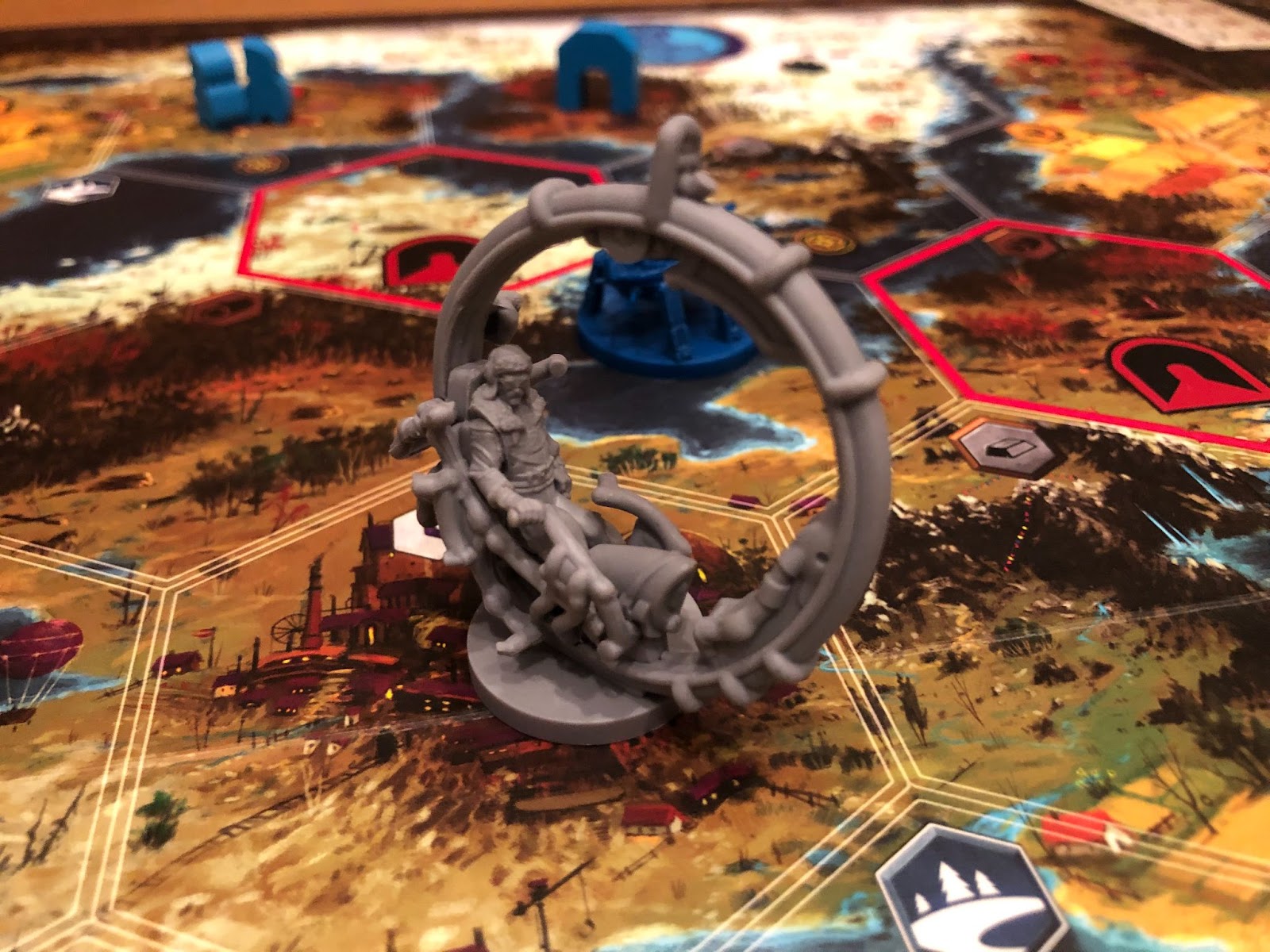 Mad Tesla starting at the Factory
Mad Tesla starting at the Factory
Instead of having Tesla helping people, another way to have him on the board is as a roaming enemy to everyone! Each round he acts last in turn order as he moves up to two territories decided by dice rolls and the Mad Tesla Tile. When he moves onto a player’s territory (or a player moves onto his territory), another die is rolled. The result of that die and the top two cards of the combat card discard pile is his total power. If the player wins the fight, Mad Tesla loses some health. If Tesla reaches 0 health, he is destroyed and the player who beat him gets an end game bonus.
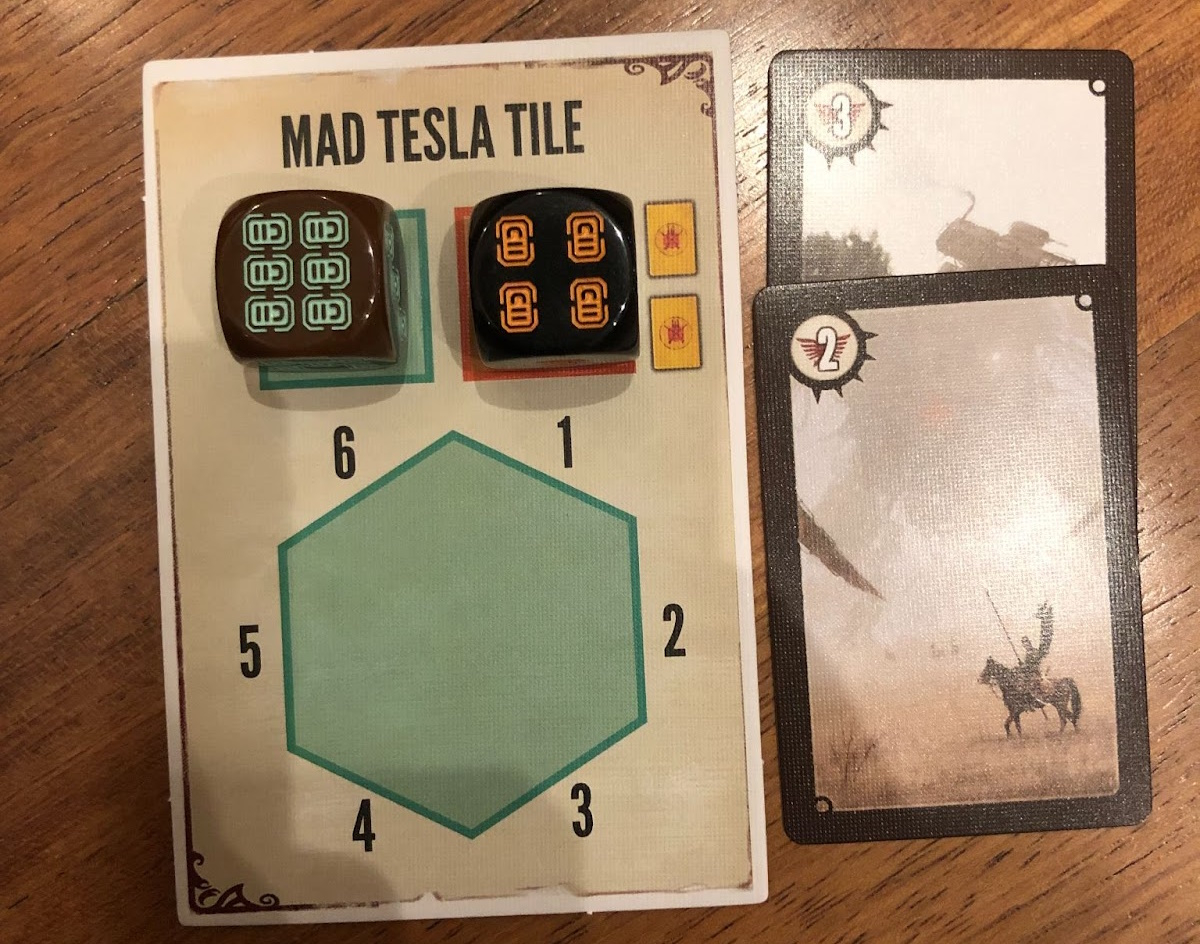 Mad Tesla Tile
Mad Tesla Tile
This is a great module to add an aggressive non-player character that mucks up plans. The threat of him coming for you adds a lot of tension that forces you to think hard about your positioning. And at the same time, it’s fun to see a force of nature tear down your opponents!
Scythe: The Rise of Fenris is available now from our webstore.
